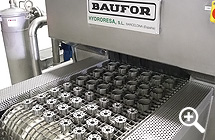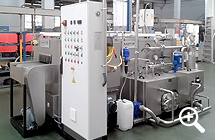Home > Case Studies > Parts Washer for Rectified Parts and Blisters
Parts Washer for Rectified Parts and Blisters
An automotive parts manufacturer required a BAUFOR parts washer to clean rectified parts and the parts-carrying trays used to transport them (blisters).
Continuous washing and drying of parts

The parts to be cleaned were manufactured from stainless steel and had metal particlees and a thin layer of oil.
The same washer had to serve to clean and dry two different types of parts. After the spray-cleaning process, maximum particle size could not exceed 700 microns and maximum particle weight could not exceed 1.5 mg every ten parts.
Parts are loaded and unloaded automatically by means of a feeder and evacuation system.
The parts washer had to be designed to optimise maintenance tasks.
Two-chamber industrial parts washer

Stainless steel pass-through conveyor belt parts washer.
The washer is manufactured from AISI-304 stainless steel and has thermal and acoustic insulation.
Continuous washing and drying of parts with speed controller.
Work cycle:
- Cleaning and degreasing.
- Blowing with compressed air (trays).
- Drying.

The parts are loaded directly onto the belt, without danger of blows or marks, due to the low conveyor speed.
Spray-cleaning with alkaline solution at a temperature between 45 °C and 45 °C and drying by means of recirculated hot air at a temperature between 45 °C and 50 °C.
Blowing can be activated or deactivated by means of a selector installed on the dashboard. In this manner, unnecessary air consumption is avoided.
Tank with 300 micron return filter housing and 50 micron filter bag up stream of the pump.
The hinged cowling and evacuation tank simplify the maintenance work.
Industrial parts washer fitted with disk type oil skimmer,oil mist collector, evacuation tank, proportional detergent dosing device and digital timer switch.
The washer also has interconnection boxes at the inlet and outlet for connection to the parts feeder and evacuation system.
- HYDRORESA, S.L.
- C/ Fogars de Tordera 65
- 08916 Badalona (Barcelona)
- +34 932 327 217
- +34 932 314 971
- baufor@baufor.com


